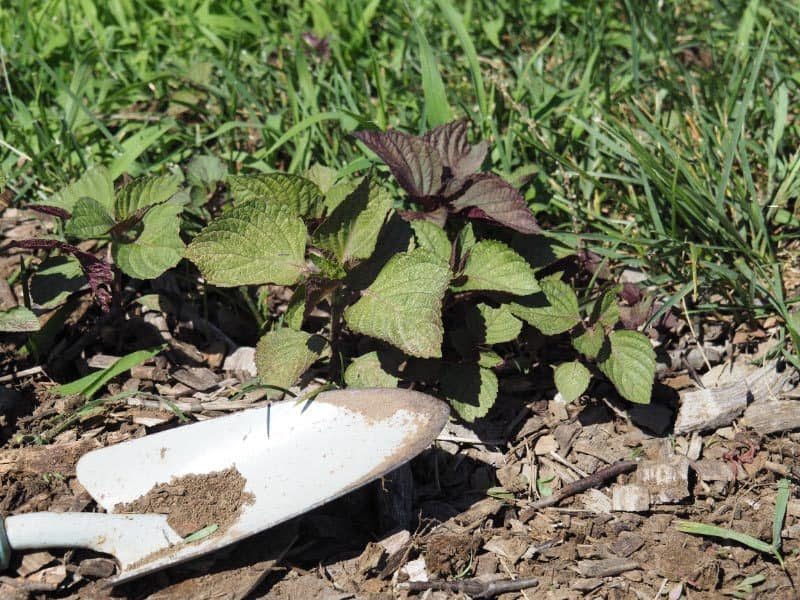Thank you to everyone who has been attentive to picking herbs in a mindful way! Please watch Ember’s informative and helpful video on “Harvesting Herbs the Right Way”. As a community, if we are all attentive to selecting herbs carefully, there will be more than enough for everyone through the rest of the season. Please cut the herb flowers as well, as they are good to eat and dry for later use. As a reminder, if you do not see a yellow circle next to the name of the herb, that means the herb is not open. At this time all the herbs are open, though that can change over the course of the season.
The following plants are now open to harvest and enjoy:
The bigger Sage – look for the longest stems and cut 1/3 of the way down with scissors only or pinch back the top cluster of leaves. Sage helps relieve coughs, sore throats and digestive issues. It also makes a calming tonic to relieve muscle tension. You can even add sage leaves to a hot bath and feel its soothing and relaxing effects.
Chives – please do not cut them all the way to the bottom!
Edible Flowers – add a pop of gorgeous colors and unexpected flavors to summers salads. When you pick edible flowers, cut the stem along with the flower. Once you get home, bathe them gently in a bath of salt water to remove any dirt or grit, then perk up the petals by dropping them in a bowl of ice water for 30-60 seconds and drain on a paper towel. Store the flowers with stems whole in a glass of water in the refrigerator until you use them. They do not keep long.
Shiso & Basil – remember to pinch the top cluster of leaves when you pick.
Rosemary – harvest by snipping a 1″-2″ sprig or two with scissors. This herb pairs beautifully with many foods and is popular in Mediterranean dishes. Its citrusy and woodsy flavor is delicious when infused in olive oil or vinegar or roasted with meats. Rosemary has anti-inflammatory and anti-bacterial properties and is thought to improve memory. It’s also been used as a symbol of remembrance and friendship for centuries.Don’t forget, the flowers of all the herbs are completely edible.
Also, feel free to hold a little handful and give the cilantro and dill a little “haircut”. Enjoy these treasures and you will benefit from their many medicinal properties!

Shiso is a member of the mint family, known as Japanese basil or perilla. It has large teardrop-shaped leaves with a slightly prickly texture and pointy, jagged edges. Its flavor is pungent and grassy, containing strong notes of spearmint, basil, anise and cinnamon. Slicing shiso into long skinny strips really brings out these flavors. Use shiso pretty much any way you would use basil or mint. It pairs well with a wide variety of foods and flavors, including rice, noodles and pasta, tofu, avocado, cucumber, mushrooms, tomato, ginger and soy sauce, sesame, fish (it’s great with tuna) and shellfish, pork and many fruits (especially plums). In Japanese, Korean and Southeast Asian cuisines, shiso is most often used as a wrapping or to flavor soups and rice. It can also be tossed into a stir-fry, ground up into a pesto sauce, tossed with some sesame seed oil and soba noodles or used in cocktails such as a shiso julep. Try it julienned and sprinkled on a simple citrus or mixed green salad, tossed into a pot of your favorite green tea or in scrambled eggs with a generous spoonful of plain, unsweetened yogurt.
Purslane is a low-lying succulent plant with a lemony flavor. It grows as a weed in the fields and in the culinary herb garden. Pull it up and try it!. Low in calories and fat, purslane is rich in dietary fiber, vitamins, anti-oxidants and minerals. Fresh leaves contain more omega-3 fatty acids (alpha-linolenic acid) than any other leafy vegetable plant: 100 grams of fresh purslane leaves provide about 350 mg of alpha-linolenic acid. Purslane also has one best sources of Vitamin A among all green leafy vegetables. It’s rich in Vitamin C, carotenoids, and some B-complex vitamins, including riboflavin, niacin and pyridoxine. It also has many dietary minerals, such as iron, magnesium, calcium, potassium, and manganese. (Note that purslane also contains oxaclic acid, in case that is a concern). Try juicing fresh, raw leaves; include tender leaves in salads; sauté and gently stew the stems and leaves to serve as a side dish with fish and poultry; add to soup and curry preparations and eat with rice, as in South Indian regional cooking, or stir-fry and mix with vegetables and other leafy greens such as spinach.
Tarragon: This plant is typically used in French cooking. It can be added fresh or dried to season vegetables, chicken, fish and vinegar. Tarragon is high in vitamins, potassium, antioxidants and other nutrients. It can also be used as an appetite stimulant and digestive aid and has been applied traditionally to provide relief from toothaches.
Mint (also open in Penelope’s Garden): This herb can be used in a variety of dishes, including salads and sauces. It also makes delicious beverages like hot and iced teas. Mint has been used to help relieve respiratory issues, aid in digestion and provide relief to sore muscles. And chewing a few leaves makes your breath minty fresh!


